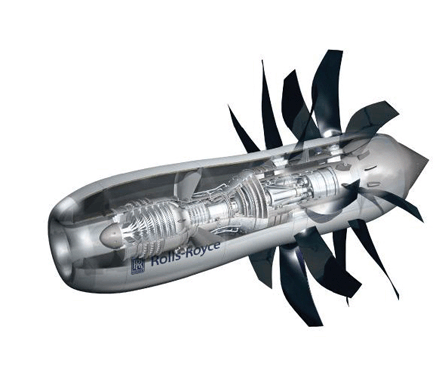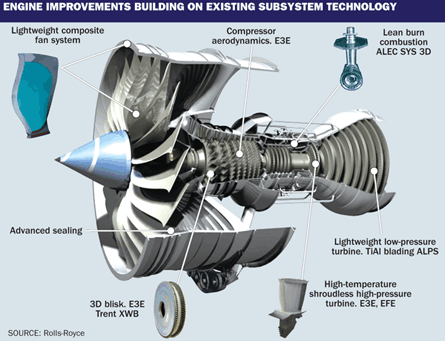Rolls-Royce stands alone among the "big three" powerplant manufacturers in its reluctance to participate in Airbus's A320neo re-engining programme, arguing that only an all-new airframe application could justify the development costs involved.
"We couldn't make a valid business case out of that opportunity," says R-R vice-president for strategic marketing Robert Nuttall. "It's for other companies to decide their business case assumptions."
The UK manufacturer thinks re-engined airliners tend to stay in production for a relatively short period and are not sold in sufficient volumes to justify the investment. Instead, the company is focused on maturing technologies it believes will find their way into the new powerplants that will equip the clean-sheet 150-seat airliner designs likely to enter service in the next decade and beyond.
 |
|---|
© Rolls-RoyceRolls-Royce has carried out extensive rig testing of open-rotor technologies |
The key is that these aircraft - unlike re-engined versions of existing airliners - will be "fully optimised at a systems level, including infrastructure to some extent", says Nuttall. R-R's broad-brush approach is aimed at readying technologies that could be applied in two- or three-shaft engines towards the end of the decade, powering narrow- or widebody airliners. Boeing recently indicated it may move to offer a new narrowbody family to replace the 737 for service entry as early as 2020.
"We said last year that we believed that successful business for an aeroengine manufacturer lay within new aircraft and new engines, closely optimised and integrated, and clearly a new Boeing aircraft fits right into that definition. Obviously we would be interested in that application," says Nuttall.
MYRIAD RESEARCH PROGRAMMES
The technologies being studied at R-R are bundled into Advance 2, which includes two-shaft engines for corporate, regional and some narrowbody airliners, in roughly the 16,000-25,000lb-thrust (70-110kN) range; Advance 3 (three-shaft engines that could power larger narrowbodies, in addition to widebodies); and open rotor.
These are made up of myriad research programmes, looking at small components all the way up to full engines that amalgamate several projects.
"We see Advance 2 as our option to come back into [the 150-seat] market when there is an appropriate aircraft that we believe we will have the longevity to make a solid business case for us," says Nuttall.
The Trent XWB - in development for the Airbus A350 long-range widebody - "slides into" Advance 3 as there is a "strong linkage" between the two, says Nuttall. "We may take Advance 3 down to way below where the Trent exists today," he adds, as the three-shaft architecture could be an attractive proposition for larger narrowbodies too.
He points out that one of the two engine options for the out-of-production Boeing 757 narrowbody was the three-shaft RB211-535. However, at lower thrust levels the components of a three-shaft engine could become too small to be practical.
Despite the fact that the two-shaft, large-fan engines offered by its competitors provide similar performance in terms of fuel burn, "we believe there is a distinct advantage to three-shaft engines", says Nuttall.
 |
|---|
"There are certainly benefits in terms of the ruggedness and stiffness of the engine, and weight," he adds.
R-R's fan and combustor technology studies are generally applicable to both Advance 2 and 3. However, compressor technology is bespoke, depending on the number of shafts in the engine.
Both Advance projects are targeted at delivering a 15-20% reduction in fuel burn compared with the engines they will replace, while providing a similar reduction in noise.
Open rotor is "more 2023-2025 in timescale" and "pretty much targeted at the middle of the market, something like 25,000-35,000lb of thrust", says Nuttall.
"We are still convinced that this is the only potential game changer."
EXTENSIVE TESTING
Fuel-burn improvement would be about 10% over an equivalent advanced turbofan, but the open rotor would be noisier, although still "quieter than anything flying today".
R-R has already carried out extensive rig testing of open-rotor technologies, and is working with the airframers to understand the installation issues.
The Environmentally Friendly Engine three-shaft core technology demonstrator is based on a fan-less Trent 1000 donor engine, "which we understand better than any other engine we've ever produced", says Nuttall. The tests in Bristol, UK involve several different engine "builds", each of which incorporates a range of experiments. The two-shaft E3E (efficiency, environment, economy) core testbed in Stuttgart, Germany incorporates "the most efficient two-shaft compressor in the world", says Nuttall.
This has already been run at sea level and at altitude. The next set of tests involve "more detailed work", which are "important as a test vehicle for whatever happens in the narrowbody, corporate and regional markets", says Nuttall.
In parallel, two sets of tests for open rotor are being run. One involves a gearbox rig, and in the third quarter of 2011 R-R will run another rig test to optimise the rotor design using its one-sixth-scale open-rotor assembly.
A European programme has been proposed to test-fly a full-scale open-rotor demonstrator as part of the Clean Sky research project, but it would take around six years to reach that milestone, and another six to certificate such a powerplant for an airframe application, meaning it would be the middle of the next decade at the earliest before an open-rotor engine could enter service.
R-R's advanced low-pressure systems study covers composite fans and fan cases, as well as lightweight low-pressure turbines. These technologies will ultimately be flight-tested in a Trent 1000.
At the components level, specific studies are focused on composite fan blades and fan cases. "A bit of an issue for us is that our titanium blade is so good that it is actually lighter than most companies' composite blades, so we have to wait for a technology step so that we can move to composite for the next generation," says Nuttall.
BETTER AERODYNAMICS
Low-pressure turbine blades are large compared with high-pressure blades, and therefore offer greater potential for weight reduction. "We're looking there at titanium aluminide as a material for the blades." Meanwhile, says Nuttall, "we are always pursuing better aerodynamics.
"Managing the air fluid through an engine is our number one job, and the biggest tool to do that is advanced computing. As we get more and more accurate data on what the air is doing we can do a better job of designing the aerofoils," he adds.
A lean-burn combustion system study known as Alecsys covers the entire fuel system. Lean-burn combustors have the potential to significantly reduce NOx.
"The trade there is that you increase complexity and weight, because of the extra burners," says Nuttall.
"In the compression section we're looking at blisks. There will be blisks in the XWB and we're looking to extend that. They've got performance, maintenance, and manufacturing benefits."
Air from the compressor is used to cool components throughout an engine. "If we waste any of that, we've wasted fuel to produce it," says Nuttall. "Therefore if we can improve the sealing within the engine we're saving fuel burn all the way down the line."
Taken together, the studies of the Advance 2 and 3 cores, composite fans and combustor technology "cover a range of architectures, de-risk them and prove that what our designers say will happen, will happen", says Nuttall. "It's a very comprehensive, broad set of technology building blocks that we can assemble into two-shaft, three-shaft and - with the exception of the fan - the open rotor.
"Basically, we're sweating every part of the engine to get the ultimate out of it. We've defined a 15-year programme, but it's all got to end up in a commercial engine and it's all got to have a benefit for customers."
Source: Flight International























